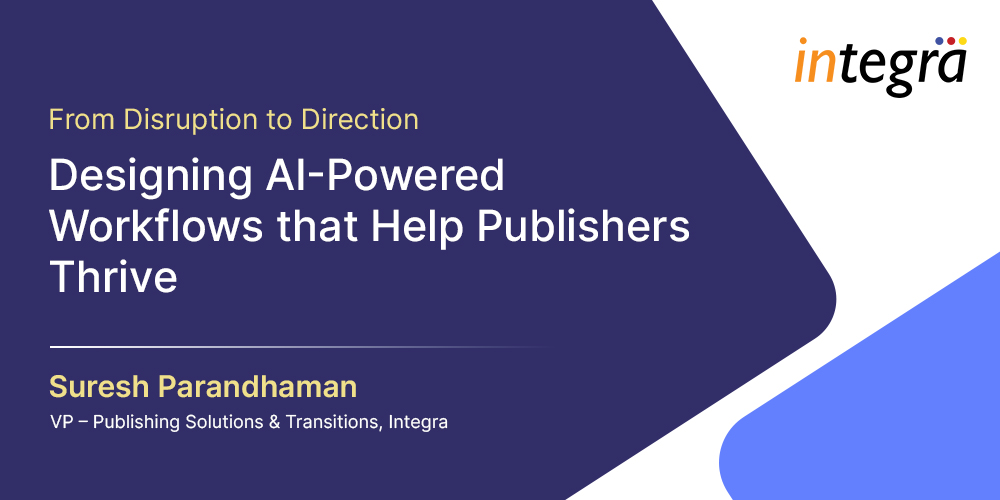PreEditPilot: AI-Powered Copyediting Made Easy
AI-powered platform to automate editing, styling, and XML generation.
Smarter Copyediting for Faster Publishing

Copyediting remains a labor-intensive and error-prone step in the publishing process. From style compliance to reference formatting and XML generation, traditional workflows often increase turnaround time, overheads, and editorial risk. PreEditPilot is Integra’s highly automated, cloud-based copyediting platform that leverages the power of our proprietary iNLP engine. PreEditPilot intelligently cleans up documents, identifies structure, standardizes styles, handles math content, and generates XML outputs on-the-fly. With support for multiple reference styles, third-party integrations (PubMed, CrossRef, ORCID), and intelligent float linking, PreEditPilot offers a complete, scalable solution for publishers looking to increase editorial quality, reduce time-to-publish, and ensure process integrity.
Looking to accelerate editing workflows with an AI-powered copyediting platform?
Let's TalkProven Impact in Scholarly Publishing
files processed
users active simultaneously
AI-Driven Editing That Structures Content and Delivers Ready-to-Publish XML
Automated Document Cleanup
Automatically detects and resolves structural inconsistencies, formatting issues, and unwanted styling elements, ensuring cleaner manuscripts with reduced manual intervention and faster editorial processing.
Multi-Style Reference Support
Supports major reference styles like APA, Chicago, Harvard, and AIP with customizable templates, helping publishers maintain consistency and meet journal-specific requirements effortlessly.
Intelligent Float Linking
Automatically links tables, figures, boxes, and related citations, ensuring structural integrity and reducing the time spent on manual tagging or cross-referencing within complex documents.
Math Content Recognition
Identifies and processes math equations accurately, supporting both MathML and LaTeX formats to streamline STEM content production and improve output quality.
AI-Based Reference Structuring
Uses NLP to analyze, structure, link, and reorder references intelligently, with integrations to PubMed, CrossRef, ORCID, and funding databases for enriched and verified metadata.
Instant XML Generation
Generates high-quality XML outputs like JATS, BITS, and DocBook in real-time, eliminating delays in production workflows and ensuring seamless delivery to downstream platforms.
Discrepancy Detection & Query Insertion
Identifies mismatches in citations, floats, and references; automatically inserts editorial queries to flag inconsistencies before they impact production quality or publishing timelines.
Get notified of our latest blogs
Explore Expert Insights

The First Step to Better Publishing Workflows? Expert Advisory
In today’s scholarly publishing landscape, the real challenge is not simply finding service providers — it’s designing a seamless, future-ready workflow that moves a manuscript from submission to acceptance quickly,...
Read More ➜
From Disruption to Direction: Designing AI-Powered Workflows that Help Publishers Thrive
Over the last two decades, I’ve seen scholarly publishing weather many changes—digital transformation, open access, globalisation of research, and now the rapid rise of AI.Each wave of change has brought...
Read More ➜
Integra: The Leading Publishing Services Partner for Scholarly and Educational Publishers
Introduction: Navigating the Modern Publishing Landscape The scholarly, academic, and K–12 publishing sectors are undergoing unprecedented transformation, presenting complex operational challenges that demand specialized solutions. Publishers today face a perfect...
Read More ➜Tell us how we can support your success
Frequently Asked Questions
Q1: What is PreEditPilot and how does it work?
PreEditPilot is an AI-powered editorial intelligence platform that analyzes manuscripts, assesses quality, and categorizes editing needs to optimize copyediting workflows and improve publishing efficiency.
Q2: How does PreEditPilot assess manuscript quality?
PreEditPilot uses advanced Natural Language Processing (NLP) to evaluate grammar, tone, clarity, structure, and adherence to publishing standards—providing detailed insights for editorial decision-making.
Q3: What are the editing levels in PreEditPilot?
PreEditPilot categorizes manuscripts into three editing levels—Light, Medium, and Heavy—based on the complexity and extent of editing required, helping prioritize editorial resources effectively.
Q4: Can PreEditPilot reduce editorial costs and turnaround time?
Yes. PreEditPilot can reduce editing costs by up to 40% and accelerate production timelines by minimizing unnecessary copyediting and distributing editorial tasks more efficiently.
Q5: Does PreEditPilot provide linguistic analysis?
Absolutely. PreEditPilot offers in-depth linguistic analysis across grammar, tone, style, and structural elements, ensuring high editorial quality and consistency across manuscripts.
Q6: Is PreEditPilot suitable for journals and academic publishers?
Yes. PreEditPilot is designed for publishers who require high-volume, high-accuracy editorial workflows—particularly useful for academic, journal, and scholarly content.
Q7: Does PreEditPilot integrate with existing publishing workflows?
Yes. PreEditPilot can be integrated into existing editorial and content management workflows, making it easy to deploy without disrupting ongoing production pipelines.
Q8: How does PreEditPilot help with resource allocation?
By automatically categorizing the editorial intensity required for each manuscript, PreEditPilot allows publishers to allocate editing tasks based on real content needs—maximizing team productivity.
Q9: Can PreEditPilot be customized for different publishing standards?
Yes. PreEditPilot supports configurable quality thresholds and can adapt to your organization’s editorial guidelines, ensuring alignment with publication-specific standards and expectations.
Q10: Is PreEditPilot part of a broader editorial suite?
Yes. PreEditPilot is part of Integra’s AI-powered publishing ecosystem and integrates well with other tools like iAuthor, ContentPilot, etc. for complete editorial workflow automation.
